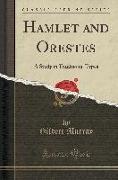Hamlet and Orestes: A Study in Traditional Types (Classic Reprint)
BücherAngebote / Angebote:
Excerpt from Hamlet and Orestes: A Study in Traditional Types
My subject is the study of two great tragic characters, Hamlet and Orestes, regarded as Traditional Types. I do not compare play with play, but simply character with character, though in the course of the comparison I shall of course consider the situations in which my heroes are placed, and the other persons with whom they are associated.
Orestes in Greek is very clearly a traditional character. He occurs in poem after poem, in tragedy after tragedy, varying slightly in each one but always true to type. He is, I think, the most central and typical tragic hero on the Greek stage, and he occurs in no less than seven of our extant tragedies eight - if we count the Iphigenia in Aulis, where he is an infant - whereas Oedipus, for instance, only comes in three and Agamemnon in four. I shall use all these seven plays as material: viz. Aeschylus, Choephori and Eumenides, Sophocles, Electra, and Euripides, Electra, Orestes, Iphigenia in Tauris, and Andromache. And before any of these plays was written Orestes was firmly fixed both in religious worship and in epic and lyric tradition.
As for Hamlet, I note in passing the well-known fragments of evidence which indicate the existence of a Hamlet-tragedy before the publication of Shakespeare's Second Quarto in 1604.
These are, counting backwards: a phrase in Dekker's Satiromastix, 1602, 'My name's Hamlet: Revenge!'
1598. Gabriel Harvey's remarks about Shakespeare's Hamlet. The true date of this entry is disputed.
1596. Lodge, Wit's Miserie and the World's Madness: 'he looks as pale as the ghost which cried so miserally at the theator like an oysterwife, Hamlet, revenge.'
1594. Henslowe's Diary records a play called Hamlet as acted at Newington Butts Theatre on June 9.
The earliest reference seems to be in Nash's Epistle prefixed to Greene's Menaphon: it is dated 1589, but was perhaps printed in 1587. 'Yet English Seneca read by candle light yeeldes many good sentences, as Bloud is a beggar, and so foorth: and if you intreate him faire in a frosty morning, he will affoord you whole Hamlets, I should say handfulls of tragicall speeches.'
The play of Hamlet is extant in three main forms:
The First Quarto, dated 1603 but perhaps printed in 1602.
About the Publisher
Forgotten Books publishes hundreds of thousands of rare and classic books. Find more at www.forgottenbooks.com
This book is a reproduction of an important historical work. Forgotten Books uses state-of-the-art technology to digitally reconstruct the work, preserving the original format whilst repairing imperfections present in the aged copy. In rare cases, an imperfection in the original, such as a blemish or missing page, may be replicated in our edition. We do, however, repair the vast majority of imperfections successfully, any imperfections that remain are intentionally left to preserve the state of such historical works.
Folgt in ca. 15 Arbeitstagen
